Contributing Factors of Dielectric Properties for Polymer Matrix Composites
Abstract
:1. Introduction
2. Influence of Polymer Matrix on Dielectric Properties of Composites
3. Influence of Fillers on Dielectric Properties of Polymer Composites
3.1. Application of Conductive Fillers in Dielectric Composites
3.2. Application of Ceramic Fillers in Dielectric Composites
3.3. Application of Polymer Fillers in Dielectric Composites
4. Influence of Structural Design to Dielectric Properties of Polymer Composites
5. Regulation Strategies of Dielectric Loss
6. Summary and Outlook
Author Contributions
Funding
Institutional Review Board Statement
Data Availability Statement
Conflicts of Interest
References
- Mendes-Felipe, C.; Barbosa, J.; Gonçalves, S.; Pereira, N.; Costa, C.; Vilas-Vilela, J.; Lanceros-Mendez, S. High dielectric constant UV curable polyurethane acrylate/indium tin oxide composites for capacitive sensing. Compos. Sci. Technol. 2020, 199, 108363. [Google Scholar] [CrossRef]
- Asiri, A.M. Inamuddin. In Ionic Polymer Metal Composites for Sensors and Actuators; Springer: Berlin/Heidelberg, Germany, 2019. [Google Scholar] [CrossRef]
- Zhang, Y.; Lin, B.; Sun, Y.; Han, P.; Wang, J.; Ding, X.; Zhang, X.; Yang, H. MoO2@ Cu@ C Composites Prepared by Using Polyoxometalates@ Metal-Organic Frameworks as Template for All-Solid-State Flexible Supercapacitor. Electrochim. Acta 2016, 188, 490–498. [Google Scholar] [CrossRef]
- Ma, T.; Zhao, Y.; Ruan, K.; Liu, X.; Zhang, J.; Guo, Y.; Yang, X.; Kong, J.; Gu, J. Highly Thermal Conductivities, Excellent Mechanical Robustness and Flexibility, and Outstanding Thermal Stabilities of Aramid Nanofiber Composite Papers with Nacre-Mimetic Layered Structures. ACS Appl. Mater. Interfaces 2019, 12, 1677–1686. [Google Scholar] [CrossRef] [PubMed]
- Zhang, D.-L.; Liu, S.-N.; Cai, H.-W.; Feng, Q.-K.; Zhong, S.-L.; Zha, J.-W.; Dang, Z.-M. Enhanced thermal conductivity and dielectric properties in electrostatic self-assembly 3D pBN@nCNTs fillers loaded in epoxy resin composites. J. Materiomics 2020, 6, 751–759. [Google Scholar] [CrossRef]
- Thakur, V.K.; Gupta, R.K. Recent Progress on Ferroelectric Polymer-Based Nanocomposites for High Energy Density Capacitors: Synthesis, Dielectric Properties, and Future Aspects. Chem. Rev. 2016, 116, 4260–4317. [Google Scholar] [CrossRef]
- Wang, B.; Huang, W.; Chi, L.; Al-Hashimi, M.; Marks, T.J.; Facchetti, A. High-k Gate Dielectrics for Emerging Flexible and Stretchable Electronics. Chem. Rev. 2018, 118, 5690–5754. [Google Scholar] [CrossRef]
- Li, Y.; Krentz, T.M.; Wang, L.; Benicewicz, B.C.; Schadler, L.S. Ligand Engineering of Polymer Nanocomposites: From the Simple to the Complex. ACS Appl. Mater. Interfaces 2014, 6, 6005–6021. [Google Scholar] [CrossRef]
- Yuan, J.-K.; Yao, S.-H.; Dang, Z.-M.; Sylvestre, A.; Genestoux, M.; Bai, J. Giant Dielectric Permittivity Nanocomposites: Realizing True Potential of Pristine Carbon Nanotubes in Polyvinylidene Fluoride Matrix through an Enhanced Interfacial Interaction. J. Phys. Chem. C 2011, 115, 5515–5521. [Google Scholar] [CrossRef]
- Dang, Z.-M.; Yuan, J.-K.; Zha, J.-W.; Zhou, T.; Li, S.-T.; Hu, G.-H. Fundamentals, processes and applications of high-permittivity polymer–matrix composites. Prog. Mater. Sci. 2012, 57, 660–723. [Google Scholar] [CrossRef]
- Fan, P.; Wang, L.; Yang, J.; Chen, F.; Zhong, M. Graphene/poly(vinylidene fluoride) composites with high dielectric constant and low percolation threshold. Nanotechnology 2012, 23, 365702. [Google Scholar] [CrossRef]
- Feng, Q.-K.; Zhong, S.-L.; Pei, J.-Y.; Zhao, Y.; Zhang, D.-L.; Liu, D.-F.; Zhang, Y.-X.; Dang, Z.-M. Recent Progress and Future Prospects on All-Organic Polymer Dielectrics for Energy Storage Capacitors. Chem. Rev. 2021, 122, 3820–3878. [Google Scholar] [CrossRef] [PubMed]
- Patel, P.K.; Rani, J.; Yadav, K. Effective strategies for reduced dielectric loss in ceramic/polymer nanocomposite film. Ceram. Int. 2020, 47, 10096–10103. [Google Scholar] [CrossRef]
- Aepuru, R.; Mondal, S.; Ghorai, N.; Kumar, V.; Panda, H.S.; Ghosh, H.N. Exploring the Carrier Dynamics in Zinc Oxide–Metal Halide-Based Perovskite Nanostructures: Toward Reduced Dielectric Loss and Improved Photocurrent. J. Phys. Chem. C 2018, 122, 27273–27283. [Google Scholar] [CrossRef]
- Li, Q.; Cheng, J.; Chen, J. Reduced dielectric loss and enhanced piezoelectric properties of Mn modified 0.71 BiFeO3–0.29 BaTiO3 ceramics sintered under oxygen atmosphere. J. Mater. Sci. Mater. Electron. 2017, 28, 1370–1377. [Google Scholar] [CrossRef]
- Deng, Y.-Y.; Zhou, D.-L.; Han, D.; Zhang, Q.; Chen, F.; Fu, Q. Fluoride ion encapsulated polyhedral oligomeric silsesquioxane: A novel filler for polymer nanocomposites with enhanced dielectric constant and reduced dielectric loss. Compos. Sci. Technol. 2020, 189, 108035. [Google Scholar] [CrossRef]
- Hu, Z.; Wang, Y.; Liu, X.; Wang, Q.; Cui, X.; Jin, S.; Yang, B.; Xia, Y.; Huang, S.; Qiang, Z.; et al. Rational design of POSS containing low dielectric resin for SLA printing electronic circuit plate composites. Compos. Sci. Technol. 2022, 223, 109403. [Google Scholar] [CrossRef]
- Zhang, Z.; Tian, D.; Niu, Z.; Zhou, Y.; Hou, X.; Ma, X. Enhanced toughness and lowered dielectric loss of reactive POSS modified bismaleimide resin as well as the silica fiber reinforced composites. Polym. Compos. 2021, 42, 6900–6911. [Google Scholar] [CrossRef]
- Zhu, L. Exploring Strategies for High Dielectric Constant and Low Loss Polymer Dielectrics. J. Phys. Chem. Lett. 2014, 5, 3677–3687. [Google Scholar] [CrossRef]
- Zhu, L.; Wang, Q. Novel Ferroelectric Polymers for High Energy Density and Low Loss Dielectrics. Macromolecules 2012, 45, 2937–2954. [Google Scholar] [CrossRef]
- He, D.; Wang, Y.; Song, S.; Liu, S.; Luo, Y.; Deng, Y. Polymer-based nanocomposites employing Bi2S3@ SiO2 nanorods for high dielectric performance: Understanding the role of interfacial polarization in semiconductor-insulator core-shell nanostructure. Compos. Sci. Technol. 2017, 151, 25–33. [Google Scholar] [CrossRef]
- Marx, P.; Wanner, A.J.; Zhang, Z.; Jin, H.; Tsekmes, I.-A.; Smit, J.J.; Kern, W.; Wiesbrock, F. Effect of Interfacial Polarization and Water Absorption on the Dielectric Properties of Epoxy-Nanocomposites. Polymers 2017, 9, 195. [Google Scholar] [CrossRef] [PubMed] [Green Version]
- Wang, Q.; Wu, C.; LaChance, A.M.; Zhou, J.; Gao, Y.; Zhang, Y.; Sun, L.; Cao, Y.; Liang, X. Interfacial polarization suppression of P(VDF-HFP) film through 2D montmorillonite nanosheets coating. Prog. Org. Coat. 2022, 172, 107119. [Google Scholar] [CrossRef]
- Zhang, X.; Ye, H.; Xu, L. Exploring the interfacial polarization in poly(vinylidene fluoride-chlorotrifluoroethylene) dielectric film with regulated surface conductivity of C@BT particles. Appl. Surf. Sci. 2022, 600, 154113. [Google Scholar] [CrossRef]
- Huang, X.; Jiang, P.; Tanaka, T. A review of dielectric polymer composites with high thermal conductivity. IEEE Electr. Insul. Mag. 2011, 27, 8–16. [Google Scholar] [CrossRef]
- Han, C.; Zhang, X.; Chen, D.; Ma, Y.; Zhao, C.; Yang, W. Enhanced dielectric properties of sandwich-structured biaxially oriented polypropylene by grafting hyper-branched aromatic polyamide as surface layers. J. Appl. Polym. Sci. 2020, 137, 48990. [Google Scholar] [CrossRef]
- Mohamed, A.T. Experimental enhancement for dielectric strength of polyethylene insulation materials using cost-fewer nanoparticles. Int. J. Electr. Power Energy Syst. 2015, 64, 469–475. [Google Scholar] [CrossRef]
- Barber, P.; Balasubramanian, S.; Anguchamy, Y.; Gong, S.; Wibowo, A.; Gao, H.; Ploehn, H.J.; Zur Loye, H.-C. Polymer Composite and Nanocomposite Dielectric Materials for Pulse Power Energy Storage. Materials 2009, 2, 1697–1733. [Google Scholar] [CrossRef] [Green Version]
- Molberg, M.; Crespy, D.; Rupper, P.; Nüesch, F.; Månson, J.-A.E.; Löwe, C.; Opris, D.M. High Breakdown Field Dielectric Elastomer Actuators Using Encapsulated Polyaniline as High Dielectric Constant Filler. Adv. Funct. Mater. 2010, 20, 3280–3291. [Google Scholar] [CrossRef]
- Abouhaswa, A.S.; Taha, T.A. Tailoring the optical and dielectric properties of PVC/CuO nanocomposites. Polym. Bull. 2019, 77, 6005–6016. [Google Scholar] [CrossRef]
- Pan, J.; Li, K.; Chuayprakong, S.; Hsu, T.; Wang, Q. High-Temperature Poly(phthalazinone ether ketone) Thin Films for Dielectric Energy Storage. ACS Appl. Mater. Interfaces 2010, 2, 1286–1289. [Google Scholar] [CrossRef]
- Coburn, J.C.; Boyd, R.H. Dielectric relaxation in poly(ethylene terephthalate). Macromolecules 1986, 19, 2238–2245. [Google Scholar] [CrossRef]
- Goyal, R.K.; Madav, V.V.; Pakankar, P.R.; Butee, S.P. Fabrication and properties of novel polyetheretherketone/barium ti-tanate composites with low dielectric loss. J. Electron. Mater. 2011, 40, 2240–2247. [Google Scholar] [CrossRef]
- Pan, J.; Li, K.; Li, J.; Hsu, T.; Wang, Q. Dielectric characteristics of poly(ether ketone ketone) for high temperature capacitive energy storage. Appl. Phys. Lett. 2009, 95, 022902. [Google Scholar] [CrossRef]
- Fang, L.; Wu, C.; Qian, R.; Xie, L.; Yang, K.; Jiang, P. Nano–micro structure of functionalized boron nitride and aluminum oxide for epoxy composites with enhanced thermal conductivity and breakdown strength. RSC Adv. 2014, 4, 21010–21017. [Google Scholar] [CrossRef]
- Song, Y.; Shen, Y.; Liu, H.; Lin, Y.; Li, M.; Nan, C.-W. Improving the dielectric constants and breakdown strength of polymer composites: Effects of the shape of the BaTiO3 nanoinclusions, surface modification and polymer matrix. J. Mater. Chem. 2012, 22, 16491–16498. [Google Scholar] [CrossRef]
- Paniagua, S.A.; Kim, Y.; Henry, K.; Kumar, R.; Perry, J.W.; Marder, S.R. Surface-Initiated Polymerization from Barium Titanate Nanoparticles for Hybrid Dielectric Capacitors. ACS Appl. Mater. Interfaces 2014, 6, 3477–3482. [Google Scholar] [CrossRef]
- Xie, L.; Huang, X.; Huang, Y.; Yang, K.; Jiang, P. Core@Double-Shell Structured BaTiO3–Polymer Nanocomposites with High Dielectric Constant and Low Dielectric Loss for Energy Storage Application. J. Phys. Chem. C 2013, 117, 22525–22537. [Google Scholar] [CrossRef]
- Gross, S.; Camozzo, D.; DI Noto, V.; Armelao, L.; Tondello, E. PMMA: A key macromolecular component for dielectric low-κ hybrid inorganic–organic polymer films. Eur. Polym. J. 2007, 43, 673–696. [Google Scholar] [CrossRef]
- Chen, T.; Zhao, Y.; Pan, L.; Lin, M. Insight into effect of hydrothermal preparation process of nanofillers on dielectric, creep and electromechanical performance of polyurethane dielectric elastomer/reduced graphene oxide composites. J. Mater. Sci. Mater. Electron. 2015, 26, 10164–10171. [Google Scholar] [CrossRef]
- Das, A.; Sinha, S.; Mukherjee, A.; Meikap, A. Enhanced dielectric properties in polyvinyl alcohol—Multiwall carbon nanotube composites. Mater. Chem. Phys. 2015, 167, 286–294. [Google Scholar] [CrossRef]
- Tuncer, E.; Sauers, I.; James, D.R.; Ellis, A.R.; Duckworth, R.C. Nanodielectric system for cryogenic applications: Barium titanate filled polyvinyl alcohol. IEEE Trans. Dielectr. Electr. Insul. 2008, 15, 236–242. [Google Scholar] [CrossRef]
- Shen, Y.; Lin, Y.H.; Nan, C.-W. Interfacial Effect on Dielectric Properties of Polymer Nanocomposites Filled with Core/Shell-Structured Particles. Adv. Funct. Mater. 2007, 17, 2405–2410. [Google Scholar] [CrossRef]
- Xie, X.; Yang, C.; Qi, X.-D.; Yang, J.-H.; Zhou, Z.-W.; Wang, Y. Constructing polymeric interlayer with dual effects toward high dielectric constant and low dielectric loss. Chem. Eng. J. 2019, 366, 378–389. [Google Scholar] [CrossRef]
- Gong, Y.; Zhou, W.; Sui, X.; Kou, Y.; Xu, L.; Duan, Y.; Chen, F.; Li, Y.; Liu, X.; Cai, H.; et al. Core-shell structured Al/PVDF nanocomposites with high dielectric permittivity but low loss and enhanced thermal conductivity. Polym. Eng. Sci. 2018, 59, 103–111. [Google Scholar] [CrossRef]
- Zhou, W.; Chen, Q.; Sui, X.; Dong, L.; Wang, Z. Enhanced thermal conductivity and dielectric properties of Al/β-SiCw/PVDF composites. Compos. Part A Appl. Sci. Manuf. 2015, 71, 184–191. [Google Scholar] [CrossRef]
- Salehiyan, R.; Nofar, M.; Makwakwa, D.; Ray, S.S. Shear-Induced Carbon Nanotube Migration and Morphological Development in Polylactide/Poly(vinylidene fluoride) Blend Nanocomposites and Their Impact on Dielectric Constants and Rheological Properties. J. Phys. Chem. C 2020, 124, 9536–9547. [Google Scholar] [CrossRef]
- Zhang, L.; Shan, X.; Bass, P.; Tong, Y.; Rolin, T.D.; Hill, C.W.; Brewer, J.C.; Tucker, D.S.; Cheng, Z.-Y. Process and Microstructure to Achieve Ultra-high Dielectric Constant in Ceramic-Polymer Composites. Sci. Rep. 2016, 6, 35763. [Google Scholar] [CrossRef] [Green Version]
- Dai, Z.-H.; Li, T.; Gao, Y.; Xu, J.; He, J.; Weng, Y.-X.; Guo, B.-H. Achieving high dielectric permittivity, high breakdown strength and high efficiency by cross-linking of poly(vinylidene fluoride)/BaTiO3 nanocomposites. Compos. Sci. Technol. 2018, 169, 142–150. [Google Scholar] [CrossRef]
- Liu, W.; Lee, S.W.; Lin, D.; Shi, F.; Wang, S.; Sendek, A.D.; Cui, Y. Enhancing ionic conductivity in composite polymer electrolytes with well-aligned ceramic nanowires. Nat. Energy 2017, 2, 17035. [Google Scholar] [CrossRef]
- Zhang, Q.M.; Li, H.; Poh, M.; Xia, F.; Cheng, Z.-Y.; Xu, H.; Huang, C. An all-organic composite actuator material with a high dielectric constant. Nature 2002, 419, 284–287. [Google Scholar] [CrossRef]
- Ltaief, A.O.; Ghorbel, N.; Benhamou, K.; Arous, M.; Kaddami, H.; Kallel, A. Impact of cellulose nanocrystals reinforcement on molecular dynamics and dielectric properties of PCL-based polyurethane. Polym. Compos. 2021, 42, 2737–2750. [Google Scholar] [CrossRef]
- Ladhar, A.; Ben Mabrouk, A.; Arous, M.; Boufi, S.; Kallel, A. Dielectric properties of nanocomposites based on cellulose nanocrystals (CNCs) and poly(styrene-co-2-ethyl hexylacrylate) copolymer. Polymer 2017, 125, 76–89. [Google Scholar] [CrossRef]
- Ma, L.; Liu, R.; Niu, H.; Zhao, M.; Huang, Y. Flexible and freestanding electrode based on polypyrrole/graphene/bacterial cellulose paper for supercapacitor. Compos. Sci. Technol. 2016, 137, 87–93. [Google Scholar] [CrossRef]
- Guo, Y.; Chen, Y.; Wang, E.; Cakmak, M. Roll-to-Roll Continuous Manufacturing Multifunctional Nanocomposites by Electric-Field-Assisted “Z” Direction Alignment of Graphite Flakes in Poly(dimethylsiloxane). ACS Appl. Mater. Interfaces 2017, 9, 919–929. [Google Scholar] [CrossRef] [PubMed]
- Martin, J.J.; Fiore, B.E.; Erb, R.M. Designing bioinspired composite reinforcement architectures via 3D magnetic printing. Nat. Commun. 2015, 6, 8641. [Google Scholar] [CrossRef] [PubMed] [Green Version]
- Xu, S.; Liu, D.; Zhang, Q.; Fu, Q. Electric field-induced alignment of nanofibrillated cellulose in thermoplastic polyurethane matrix. Compos. Sci. Technol. 2017, 156, 117–126. [Google Scholar] [CrossRef]
- Kadimi, A.; Benhamou, K.; Ounaies, Z.; Magnin, A.; Dufresne, A.; Kaddami, H.; Raihane, M. Electric Field Alignment of Nanofibrillated Cellulose (NFC) in Silicone Oil: Impact on Electrical Properties. ACS Appl. Mater. Interfaces 2014, 6, 9418–9425. [Google Scholar] [CrossRef]
- Tsyganov, A.; Vikulova, M.; Artyukhov, D.; Bainyashev, A.; Goffman, V.; Gorokhovsky, A.; Boychenko, E.; Burmistrov, I.; Gorshkov, N. Permittivity and Dielectric Loss Balance of PVDF/K1.6Fe1.6Ti6.4O16/MWCNT Three-Phase Composites. Polymers 2022, 14, 4609. [Google Scholar] [CrossRef]
- Deeba, F.; Gupta, A.K.; Kulshrestha, V.; Bafna, M.; Jain, A. Analysing the dielectric properties of ZnO doped PVDF/PMMA blend composite. J. Mater. Sci. Mater. Electron. 2022, 33, 23703–23713. [Google Scholar] [CrossRef]
- Celebi, H.; Duran, S.; Dogan, A. The effect of core-shell BaTiO3@ SiO2 on the mechanical and dielectric properties of PVDF composites. Polym.-Plast. Technol. Mater. 2022, 61, 1191–1203. [Google Scholar] [CrossRef]
- Silakaew, K.; Swatsitang, E.; Thongbai, P. Novel polymer composites of RuO2@ nBaTiO3/PVDF with a high dielectric constant. Ceram. Int. 2022, 48, 18925–18932. [Google Scholar] [CrossRef]
- Jing, L.; Li, W.; Gao, C.; Li, M.; Fei, W. Excellent energy storage properties achieved in PVDF-based composites by designing the lamellar-structured fillers. Compos. Sci. Technol. 2022, 227, 109568. [Google Scholar] [CrossRef]
- Zhang, T.; Sun, Q.; Kang, F.; Wang, Z.; Xue, R.; Wang, J.; Zhang, L. Sandwich-structured polymer dielectric composite films for improving breakdown strength and energy density at high temperature. Compos. Sci. Technol. 2022, 227, 109596. [Google Scholar] [CrossRef]
- Li, Z.; Shen, Z.; Yang, X.; Zhu, X.; Zhou, Y.; Dong, L.; Xiong, C.; Wang, Q. Ultrahigh charge-discharge efficiency and enhanced energy density of the sandwiched polymer nanocomposites with poly(methyl methacrylate) layer. Compos. Sci. Technol. 2020, 202, 108591. [Google Scholar] [CrossRef]
- Liao, Y.; Weng, Y.; Wang, J.; Zhou, H.; Lin, J.; He, S. Silicone Rubber Composites with High Breakdown Strength and Low Dielectric Loss Based on Polydopamine Coated Mica. Polymers 2019, 11, 2030. [Google Scholar] [CrossRef] [Green Version]
- Anjeline, C.J.; Mali, D.; Lakshminarasimhan, N. High dielectric constant of NiFe2O4–LaFeO3 nanocomposite: Interfacial conduction and dielectric loss. Ceram. Int. 2021, 47, 34278–34288. [Google Scholar] [CrossRef]
- Wang, H.; Wang, Q.; Zhang, Q.; Yang, H.; Dong, J.; Cheng, J.; Tong, J.; Wen, J. High thermal conductive composite with low dielectric constant and dielectric loss accomplished through flower-like Al2O3 coated BNNs for advanced circuit substrate applications. Compos. Sci. Technol. 2021, 216, 109048. [Google Scholar] [CrossRef]
- Huang, Z.-X.; Zhao, M.-L.; Zhang, G.-Z.; Song, J.; Qu, J.-P. Controlled localizing multi-wall carbon nanotubes in polyvinylidene fluoride/acrylonitrile butadiene styrene blends to achieve balanced dielectric constant and dielectric loss. Compos. Sci. Technol. 2021, 212, 108874. [Google Scholar] [CrossRef]
- Ding, X.; Pan, Z.; Zhang, Y.; Shi, S.; Cheng, Y.; Chen, H.; Li, Z.; Fan, X.; Liu, J.; Yu, J.; et al. Regulation of Interfacial Polarization and Local Electric Field Strength Achieved Highly Energy Storage Performance in Polyetherimide Nanocomposites at Elevated Temperature via 2D Hybrid Structure. Adv. Mater. Interfaces 2022, 9, 2201100. [Google Scholar] [CrossRef]
- Bouiri, E.M.; Farhan, R.; Chakhchaoui, N.; Oumghar, K.; Denktas, C.; Eddiai, A.; Meddad, M.; Mazroui, M.; Cherkaoui, O.; Omari, L.E.H. Improving dielectric properties of composites thin films with polylactic acid and PZT microparticles induced by interfacial polarization. Eur. Phys. J. Appl. Phys. 2022, 97, 64. [Google Scholar] [CrossRef]
- Bronnikov, S.; Kostromin, S.; Asandulesa, M.; Pankin, D.; Podshivalov, A. Interfacial interactions and interfacial polarization in polyazomethine/MWCNTs nanocomposites. Compos. Sci. Technol. 2020, 190, 108049. [Google Scholar] [CrossRef]
- Kuang, X.; Liu, Z.; Zhu, H. Dielectric properties of Ag@ C/PVDF composites. J. Appl. Polym. Sci. 2013, 129, 3411–3416. [Google Scholar] [CrossRef]
- Tuichai, W.; Kum-Onsa, P.; Danwittayakul, S.; Manyam, J.; Harnchana, V.; Thongbai, P.; Phromviyo, N.; Chindaprasirt, P. Significantly Enhanced Dielectric Properties of Ag-Deposited (In1/2Nb1/2)0.1Ti0.9O2/PVDF Polymer Composites. Polymers 2021, 13, 1788. [Google Scholar] [CrossRef] [PubMed]
- Kaur, M.; Kumar, V.; Singh, J.; Datt, J.; Sharma, R. Effect of Cu-N co-doping on the dielectric properties of ZnO nanoparticles. Mater. Technol. 2022, 37, 2644–2658. [Google Scholar] [CrossRef]
- Huang, A.; Liu, F.; Cui, Z.; Wang, H.; Song, X.; Geng, L.; Peng, X. Novel PTFE/CNT composite nanofiber membranes with enhanced mechanical, crystalline, conductive, and dielectric properties fabricated by emulsion electrospinning and sintering. Compos. Sci. Technol. 2021, 214, 108980. [Google Scholar] [CrossRef]
- Fan, X.; Zhang, A.; Li, M.; Xu, H.; Xue, J.; Ye, F.; Cheng, L. A reduced graphene oxide/bi-MOF-derived carbon composite as high-performance microwave absorber with tunable dielectric properties. J. Mater. Sci. Mater. Electron. 2020, 31, 11774–11783. [Google Scholar] [CrossRef]
- Zhang, L.; Yuan, S.; Chen, S.; Wang, D.; Han, B.-Z.; Dang, Z.-M. Preparation and dielectric properties of core–shell structured Ag@polydopamine/poly(vinylidene fluoride) composites. Compos. Sci. Technol. 2015, 110, 126–131. [Google Scholar] [CrossRef]
- Wang, Y.; Zhu, L.; Zhou, J.; Jia, B.; Jiang, Y.; Wang, J.; Wang, M.; Cheng, Y.; Wu, K. Dielectric properties and thermal conductivity of epoxy resin composite modified by Zn/ZnO/Al2O3 core–shell particles. Polym. Bull. 2018, 76, 3957–3970. [Google Scholar] [CrossRef]
- Mei, B.; Qin, Y.; Agbolaghi, S. A review on supramolecules/nanocomposites based on carbonic precursors and dielectric/conductive polymers and their applications. Mater. Sci. Eng. B 2021, 269, 115181. [Google Scholar] [CrossRef]
- Chen, Y.; Lin, B.; Zhang, X.; Wang, J.; Lai, C.; Sun, Y.; Liu, Y.; Yang, H. Enhanced dielectric properties of amino-modified-CNT/polyimide composite films with a sandwich structure. J. Mater. Chem. A 2014, 2, 14118–14126. [Google Scholar] [CrossRef]
- Wang, J. High-Performance Dielectric Ceramic for Energy Storage Capacitors. Coatings 2022, 12, 889. [Google Scholar] [CrossRef]
- Feng, Y.; Li, W.L.; Hou, Y.F.; Yu, Y.; Cao, W.P.; Zhang, T.D.; Fei, W.D. Enhanced dielectric properties of PVDF-HFP/BaTiO3-nanowire composites induced by interfacial polarization and wire-shape. J. Mater. Chem. C 2014, 3, 1250–1260. [Google Scholar] [CrossRef]
- Pan, Z.; Yao, L.; Zhai, J.; Shen, B.; Wang, H. Significantly improved dielectric properties and energy density of polymer nanocomposites via small loaded of BaTiO3 nanotubes. Compos. Sci. Technol. 2017, 147, 30–38. [Google Scholar] [CrossRef]
- Ding, C.; Yu, S.; Tang, X.; Liu, Z.; Luo, H.; Zhang, Y.; Zhang, D.; Chen, S. The design and preparation of high-performance ABS-based dielectric composites via introducing core-shell polar polymers@ BaTiO3 nanoparticles. Compos. Part A Appl. Sci. Manuf. 2022, 163, 107214. [Google Scholar] [CrossRef]
- Costa, C.; Reizabal, A.; i Serra, R.S.; Balado, A.A.; Pérez-Álvarez, L.; Ribelles, J.G.; Vilas-Vilela, J.; Lanceros-Méndez, S. Broadband dielectric response of silk Fibroin/BaTiO3 composites: Influence of nanoparticle size and concentration. Compos. Sci. Technol. 2021, 213, 108927. [Google Scholar] [CrossRef]
- Chen, J.; Huang, F.; Zhang, C.; Meng, F.; Cao, L.; Lin, H. Enhanced energy storage density in poly(vinylidene fluoride-hexafluoropropylene) nanocomposites by filling with core-shell structured BaTiO3@ MgO nanoparticals. J. Energy Storage 2022, 53, 105163. [Google Scholar] [CrossRef]
- Chen, J.; Zhou, C.; Cai, W.; Huang, F.; Zhang, C.; Cao, L.; Meng, F. Pluronic F127-modified BaTiO3 for ceramic/polymer nanocomposite dielectric capacitor with enhanced energy storage performance. Polym. Eng. Sci. 2022, 62, 1811–1822. [Google Scholar] [CrossRef]
- Li, H.; Fu, Y.; Alhashmialameer, D.; Thabet, H.K.; Zhang, P.; Wang, C.; Zhu, K.; Huang, M.; Guo, Z.; Dang, F. Lattice distortion embedded core–shell nanoparticle through epitaxial growth barium titanate shell on the strontium titanate core with enhanced dielectric response. Adv. Compos. Hybrid Mater. 2022, 5, 2631–2641. [Google Scholar] [CrossRef]
- Yang, K.; Huang, X.; Zhu, M.; Xie, L.; Tanaka, T.; Jiang, P. Combining RAFT Polymerization and Thiol–Ene Click Reaction for Core–Shell Structured Polymer@BaTiO3 Nanodielectrics with High Dielectric Constant, Low Dielectric Loss, and High Energy Storage Capability. ACS Appl. Mater. Interfaces 2014, 6, 1812–1822. [Google Scholar] [CrossRef]
- Wu, W.; Ren, T.; Liu, X.; Huai, K.; Cui, X.; Wei, H.; Hu, J.; Xia, Y.; Huang, S.; Fu, K.; et al. Electric field-assisted preparation of PANI/TPU all-organic composites with enhanced dielectric permittivity and anisotropic optical properties. Polym. Eng. Sci. 2022, 62, 3945–3951. [Google Scholar] [CrossRef]
- Wei, H.; Yuan, Y.; Ren, T.; Zhou, L.; Liu, X.; Saeed, H.A.M.; Jin, P.; Chen, Y. High-Dielectric PVP@PANI/PDMS Composites Fabricated via an Electric Field-Assisted Approach. Polymers 2022, 14, 4381. [Google Scholar] [CrossRef] [PubMed]
- Wang, Q.; Liu, X.; Qiang, Z.; Hu, Z.; Cui, X.; Wei, H.; Hu, J.; Xia, Y.; Huang, S.; Zhang, J.; et al. Cellulose nanocrystal enhanced, high dielectric 3D printing composite resin for energy applications. Compos. Sci. Technol. 2022, 227, 109601. [Google Scholar] [CrossRef]
- Dash, K.; Hota, N.K.; Sahoo, B.P. Fabrication of thermoplastic polyurethane and polyaniline conductive blend with improved mechanical, thermal and excellent dielectric properties: Exploring the effect of ultralow-level loading of SWCNT and temperature. J. Mater. Sci. 2020, 55, 12568–12591. [Google Scholar] [CrossRef]
- Zhang, Q.; Jiang, Y.; Yu, E.; Yang, H. Significantly enhanced dielectric properties of P(VDF-HFP) composite films filled with core-shell BaTiO3@ PANI nanoparticles. Surf. Coat. Technol. 2018, 358, 293–298. [Google Scholar] [CrossRef]
- Rahnamol, A.M.; Gopalakrishnan, J. Improved dielectric and dynamic mechanical properties of epoxy/polyaniline nanorod/ in situ reduced graphene oxide hybrid nanocomposites. Polym. Compos. 2020, 41, 2998–3013. [Google Scholar] [CrossRef]
- Khouaja, A.; Koubaa, A.; Ben Daly, H. Dielectric properties and thermal stability of cellulose high-density polyethylene bio-based composites. Ind. Crop. Prod. 2021, 171, 113928. [Google Scholar] [CrossRef]
- Guo, Q.; Xue, Q.; Wu, T.; Pan, X.; Zhang, J.; Li, X.; Zhu, L. Excellent dielectric properties of PVDF-based composites filled with carbonized PAN/PEG copolymer fibers. Compos. Part A Appl. Sci. Manuf. 2016, 87, 46–53. [Google Scholar] [CrossRef]
- Wang, P.; Yin, Y.; Fang, L.; He, J.; Wang, Y.; Cai, H.; Yang, Q.; Shi, Z.; Xiong, C. Flexible cellulose/PVDF composite films with improved breakdown strength and energy density for dielectric capacitors. Compos. Part A Appl. Sci. Manuf. 2023, 164, 107325. [Google Scholar] [CrossRef]
- Chen, Y.; Liu, Y.; Yang, J.; Zhang, B.; Hu, Z.; Wang, Q.; Wu, W.; Shang, Y.; Xia, Y.; Duan, Y.; et al. Fabrication of high dielectric permittivity polymer composites by architecting aligned micro-enhanced-zones of ultralow content graphene using electric fields. Mater. Today Commun. 2019, 21, 100649. [Google Scholar] [CrossRef]
- Chen, Y.; Liu, Y.; Xia, Y.; Liu, X.; Qiang, Z.; Yang, J.; Zhang, B.; Hu, Z.; Wang, Q.; Wu, W.; et al. Electric Field-Induced Assembly and Alignment of Silver-Coated Cellulose for Polymer Composite Films with Enhanced Dielectric Permittivity and Anisotropic Light Transmission. ACS Appl. Mater. Interfaces 2020, 12, 24242–24249. [Google Scholar] [CrossRef]
- Tang, H.; Lin, Y.; Sodano, H.A. Enhanced Energy Storage in Nanocomposite Capacitors through Aligned PZT Nanowires by Uniaxial Strain Assembly. Adv. Energy Mater. 2012, 2, 469–476. [Google Scholar] [CrossRef]
- Zhang, X.; Jiang, J.; Shen, Z.; Dan, Z.; Li, M.; Lin, Y.; Nan, C.; Chen, L.; Shen, Y. Polymer Nanocomposites with Ultrahigh Energy Density and High Discharge Efficiency by Modulating their Nanostructures in Three Dimensions. Adv. Mater. 2018, 30, e1707269. [Google Scholar] [CrossRef] [PubMed]
- Zhang, Y.; Zhang, C.; Feng, Y.; Zhang, T.; Chen, Q.; Chi, Q.; Liu, L.; Li, G.; Cui, Y.; Wang, X. Excellent energy storage performance and thermal property of polymer-based composite induced by multifunctional one-dimensional nanofibers oriented in-plane direction. Nano Energy 2019, 56, 138–150. [Google Scholar] [CrossRef]
- Luo, H.; Zhou, X.; Ellingford, C.; Zhang, Y.; Chen, S.; Zhou, K.; Zhang, D.; Bowen, C.R.; Wan, C. Interface design for high energy density polymer nanocomposites. Chem. Soc. Rev. 2019, 48, 4424–4465. [Google Scholar] [CrossRef] [PubMed] [Green Version]
- Huang, Y.; Huang, X.; Schadler, L.S.; He, J.; Jiang, P. Core@ Double-Shell Structured Nanocomposites: A Route to High Dielectric Constant and Low Loss Material. ACS Appl. Mater. Interfaces 2016, 8, 25496–25507. [Google Scholar] [CrossRef] [PubMed]
- Wang, D.; Bao, Y.; Zha, J.-W.; Zhao, J.; Dang, Z.-M.; Hu, G.-H. Improved Dielectric Properties of Nanocomposites Based on Poly(vinylidene fluoride) and Poly(vinyl alcohol)-Functionalized Graphene. ACS Appl. Mater. Interfaces 2012, 4, 6273–6279. [Google Scholar] [CrossRef]
- Yang, K.; Huang, X.; Xie, L.; Wu, C.; Jiang, P.; Tanaka, T. Core-Shell Structured Polystyrene/BaTiO3 Hybrid Nanodielectrics Prepared by In Situ RAFT Polymerization: A Route to High Dielectric Constant and Low Loss Materials with Weak Frequency Dependence. Macromol. Rapid Commun. 2012, 33, 1921–1926. [Google Scholar] [CrossRef]
- Wu, W.; Liu, X.; Qiang, Z.; Yang, J.; Liu, Y.; Huai, K.; Zhang, B.; Jin, S.; Xia, Y.; Fu, K.K.; et al. Inserting insulating barriers into conductive particle channels: A new paradigm for fabricating polymer composites with high dielectric permittivity and low dielectric loss. Compos. Sci. Technol. 2021, 216, 109070. [Google Scholar] [CrossRef]
- Abutalib, M.M.; Rajeh, A. Boosting optical and electrical characteristics of polyvinyl alcohol/carboxymethyl cellulose nanocomposites by GNPs/MWCNTs fillers as an application in energy storage devices. Int. J. Energy Res. 2021, 46, 6216–6224. [Google Scholar] [CrossRef]


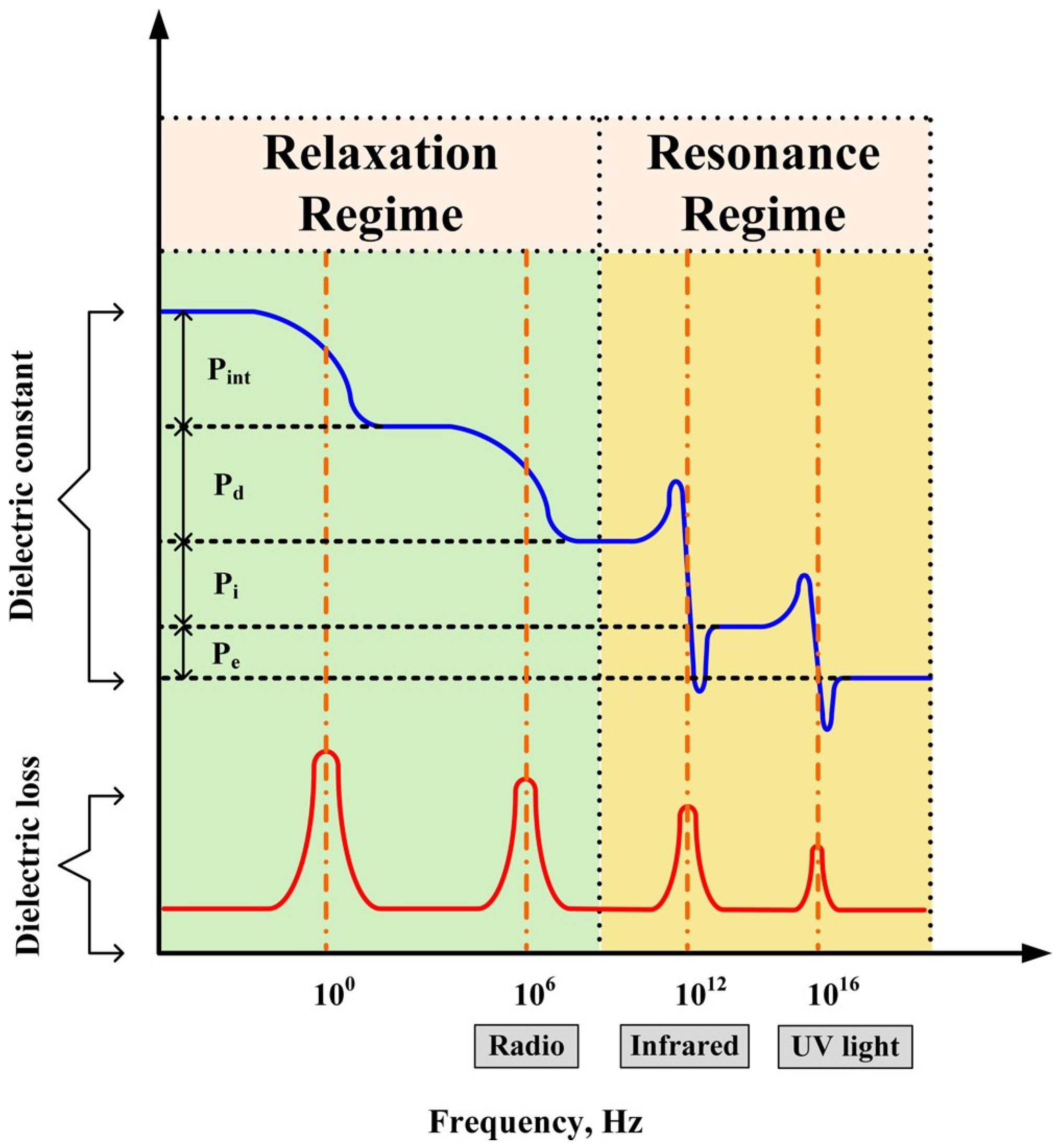
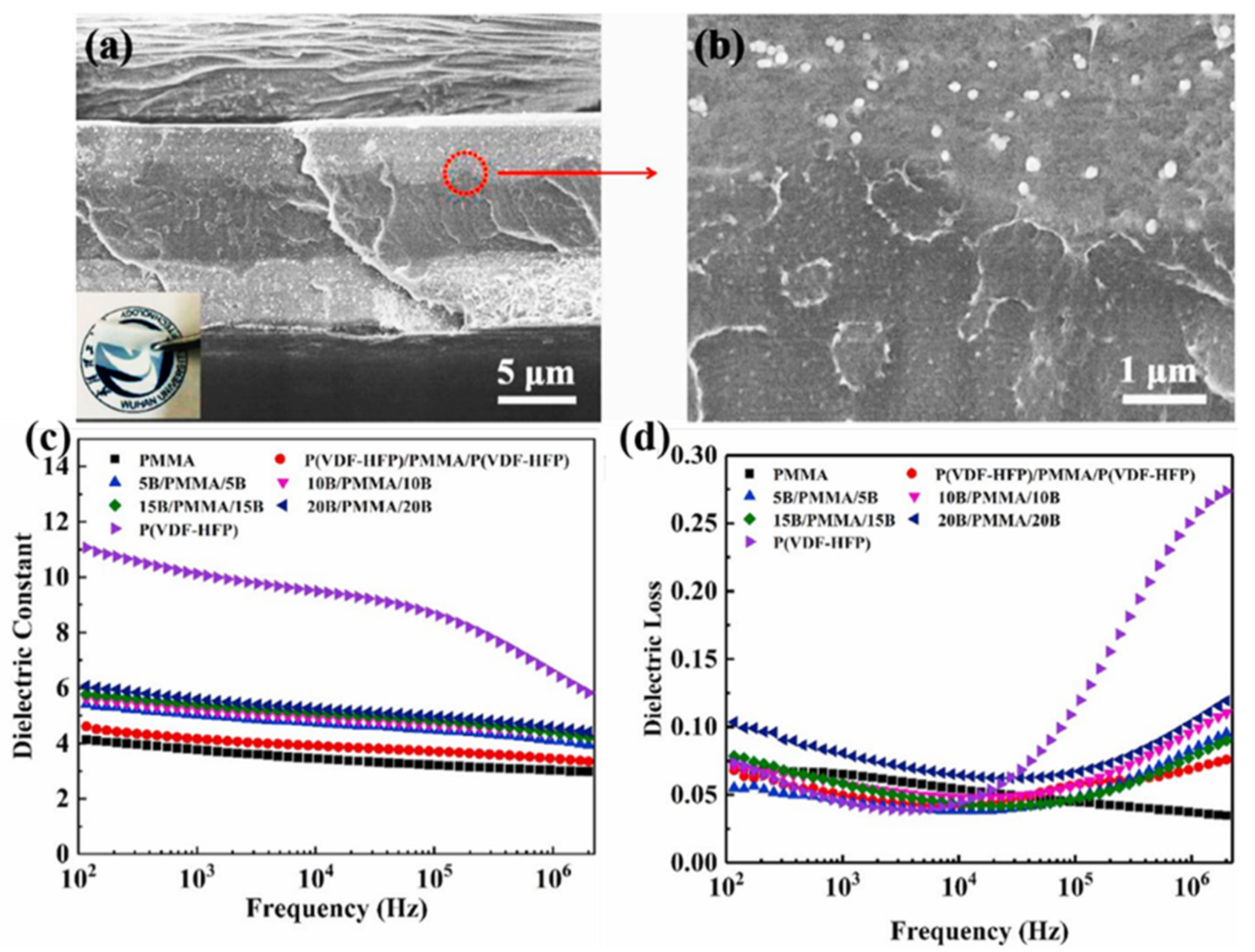
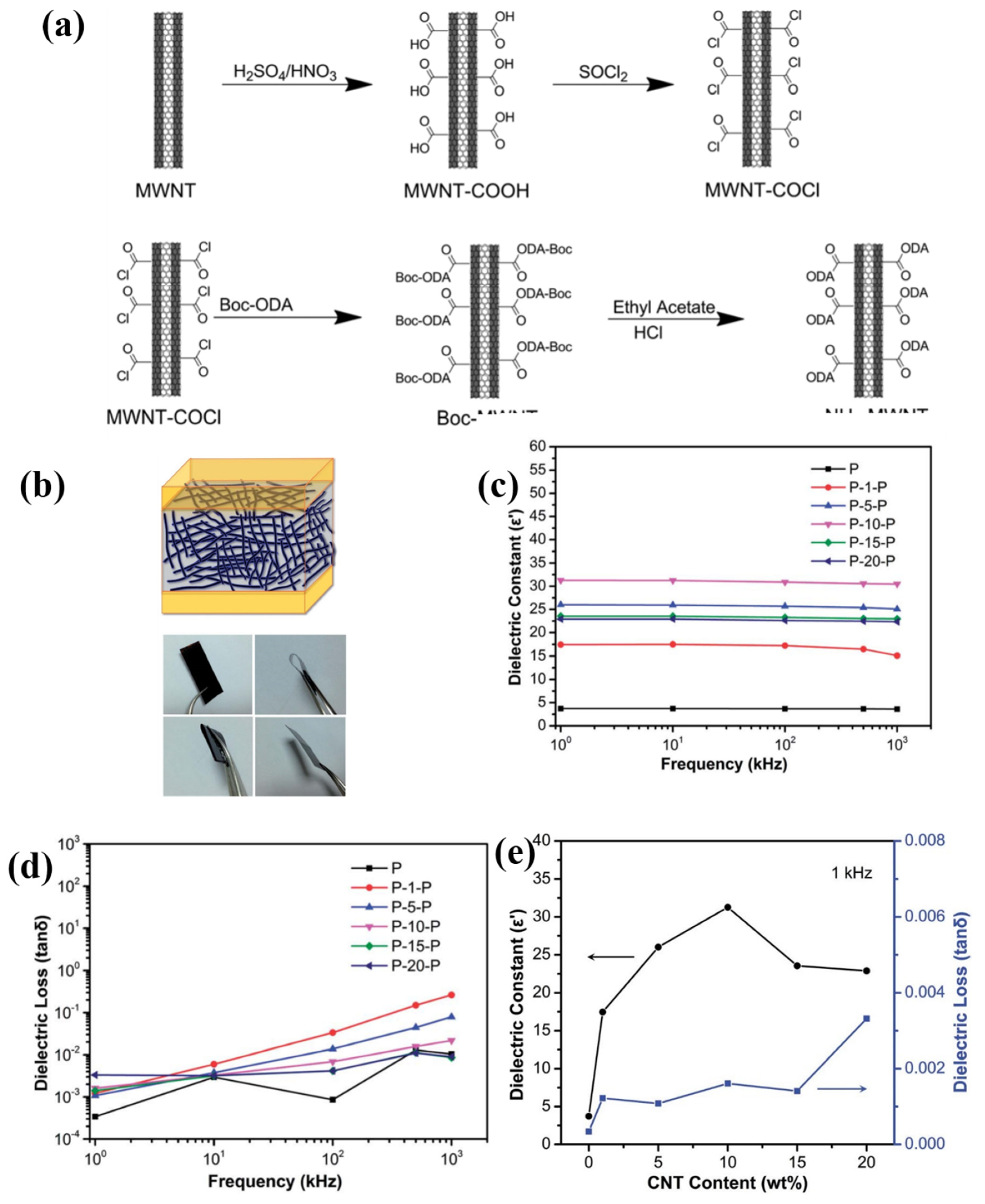
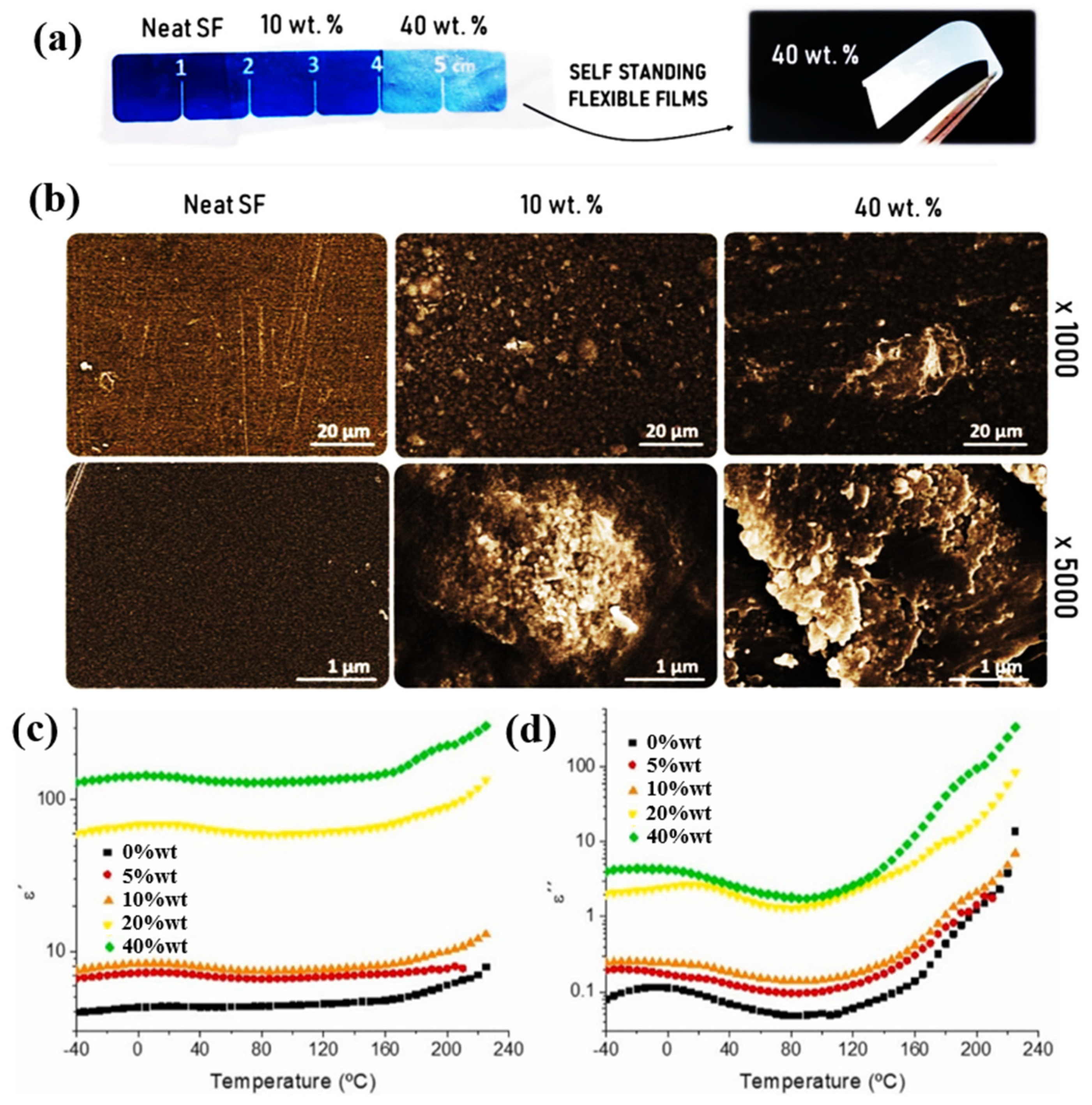
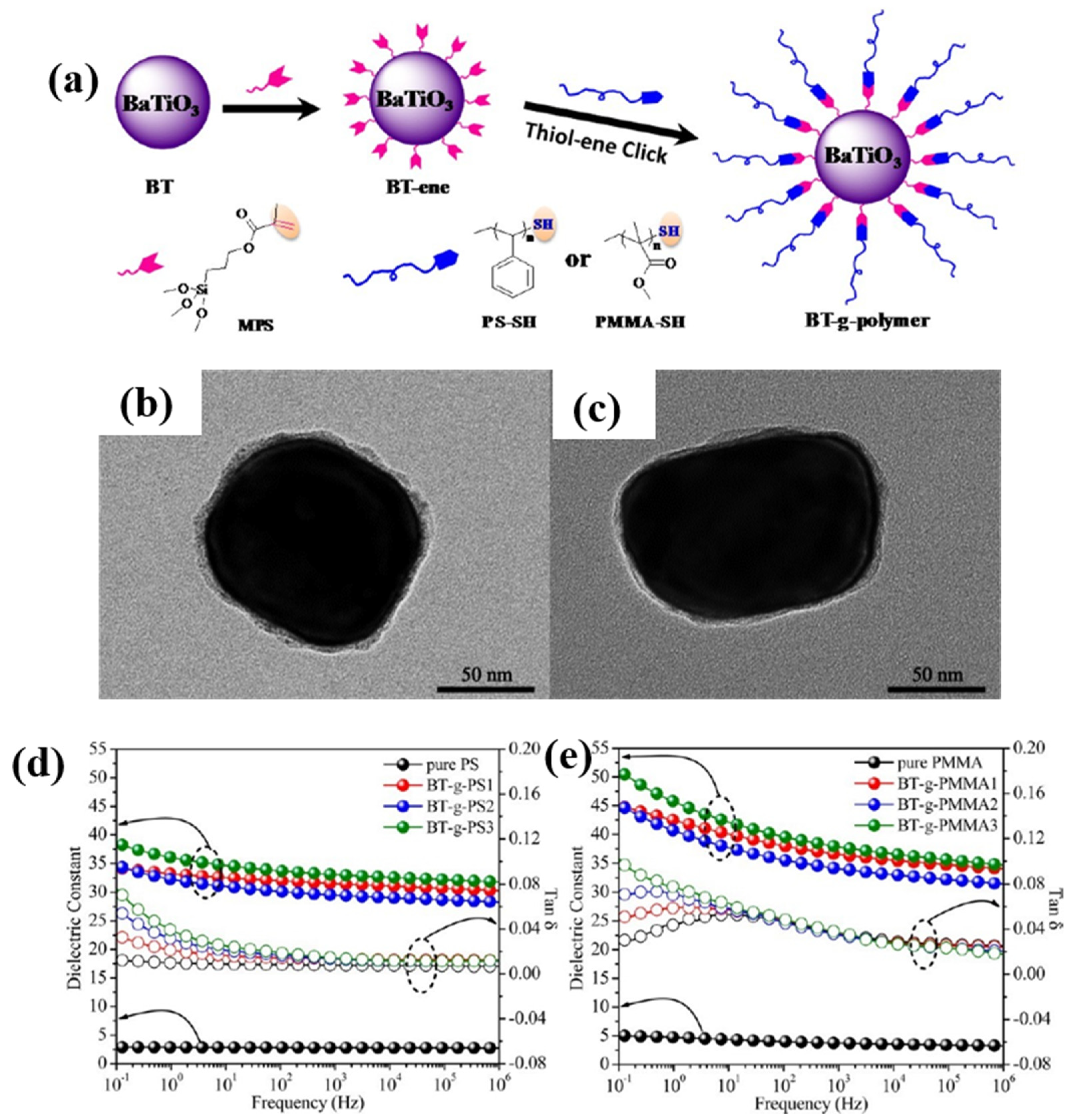

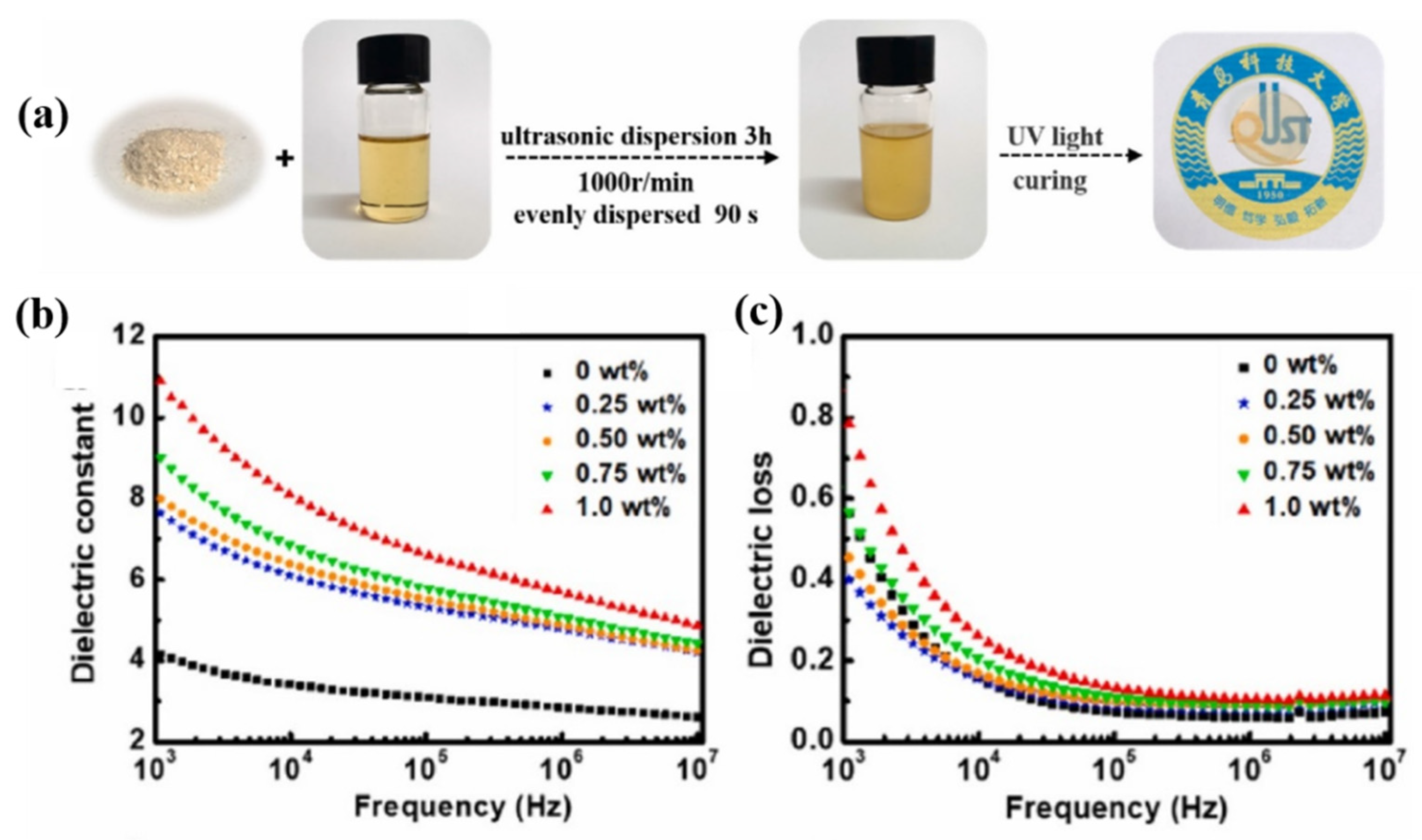
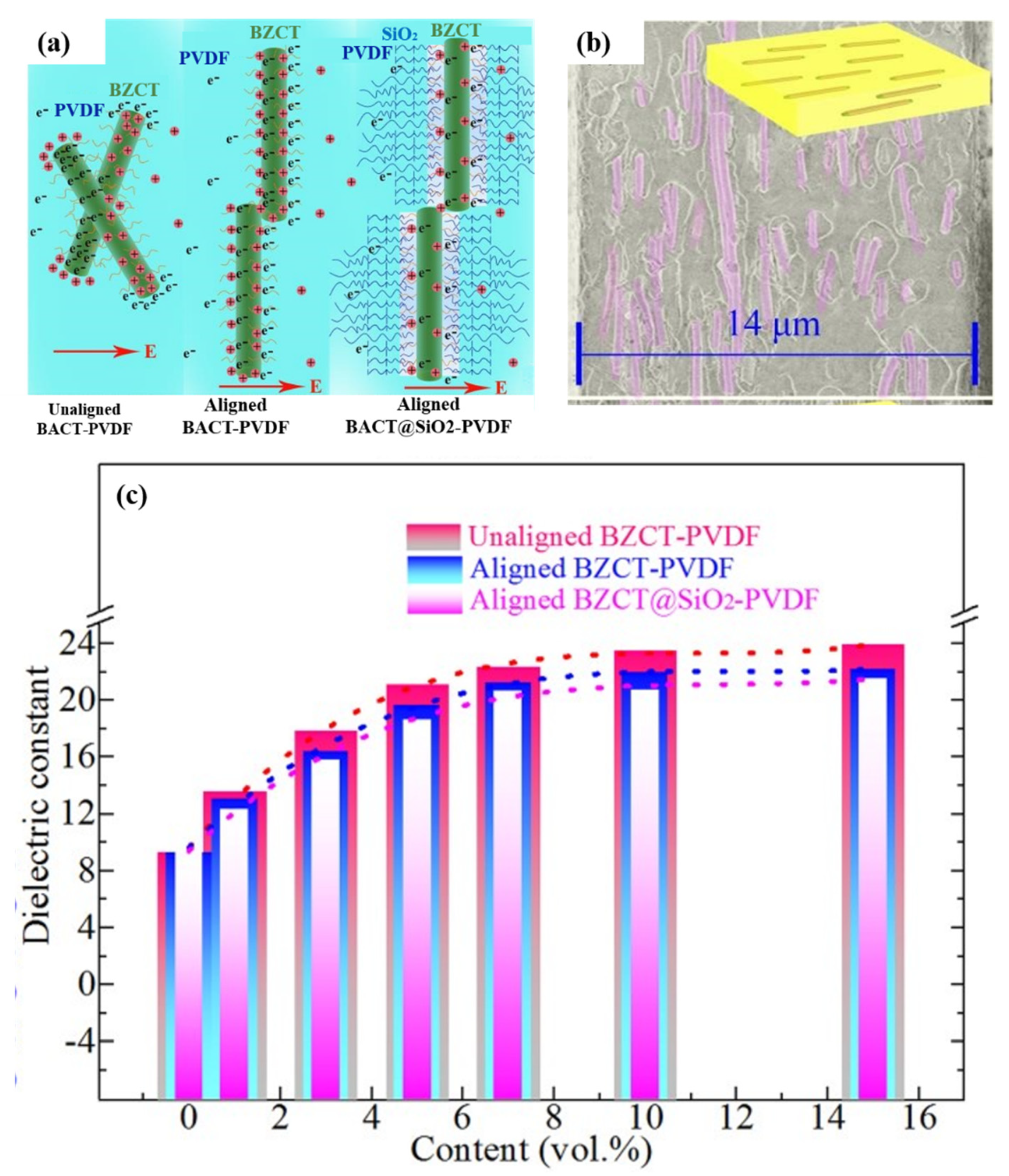
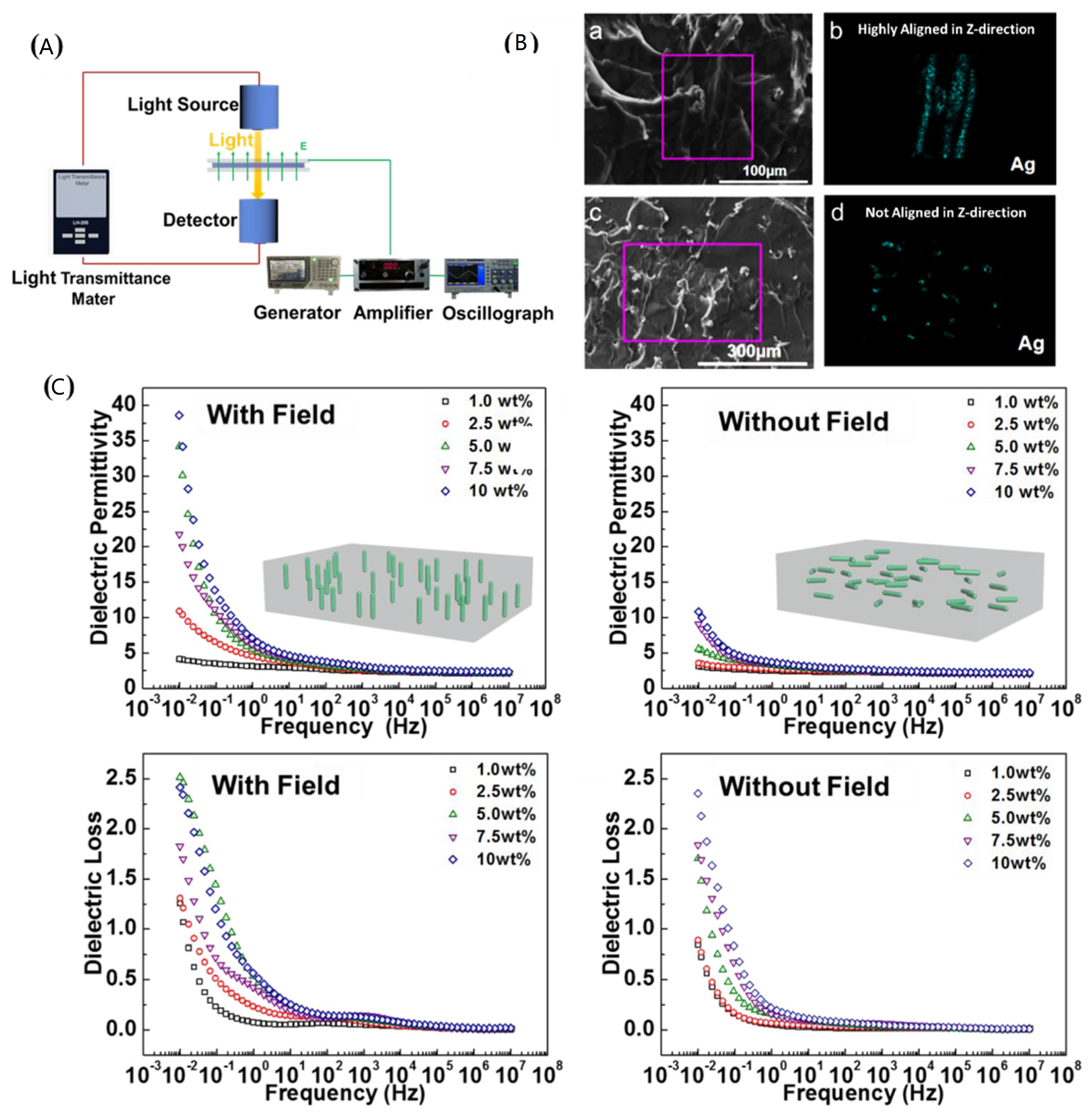


| Polymer Materials | Dielectric Permittivity (1 KHz) | Loss Tangent (1 KHz) | References |
|---|---|---|---|
| Polytetrafluoroethylene (PTFE) | 2 | 0.0001 | [25] |
| Biaxially oriented polypropylene (BOPP) | 2.2 | 0.0002 | [26] |
| Low-Density Polyethylene (LDPE) | 2.3 | 0.003 | [25,27] |
| High-Density Polyethylene (HDPE) | 2.3 | 0.0002–0.0007 | [25,27] |
| Polystyrene (PS) | 2.4–2.7 | 0.008 | [28] |
| Polydimethyl siloxane (PDMS) | 2.6 | 0.01 | [25,29] |
| Polycarbonate (PC) | 3.0 | 0.0015 | [28] |
| Polyvinyl chloride (PVC) | 3.4 | 0.018 | [30] |
| Polyimide (PI) | 3.5 | 0.04 | [31] |
| Polyethylene glycol terephthalate (PET) | 3.6 | 0.01 | [25,32] |
| Poly(ether-ether-ketone) (PEEK) | 4.0 | 0.009 (100 KHz) | [25,33,34] |
| Epoxy | 4.5 | 0.015 | [25,28,35,36] |
| Polymethyl methacrylate (PMMA) | 4.5 | 0.05 | [25,37,38,39] |
| Polyurethane (PU) | 4.6 | 0.02 | [40] |
| Polyvinylidene difluoride (PVDF) | 10 | 0.04 | [36] |
| Polyvinyl alcohol (PVA) | 12 | 0.3 | [41,42] |
| Type of Filler | Common Materials | Advantages | Disadvantages | References |
|---|---|---|---|---|
| Conductive fillers | Ag, Au, CNTs, Graphene, etc. | High dielectric | Difficult to disperse; Poor compatibility | [44,45,46,47] |
| Ceramic fillers | BaSrTiO3, BaTiO3, CaCuTiO3, etc. | High dielectric | High dielectric loss; Poor compatibility | [48,49,50] |
| Polar polymers | CNCs, PAN, etc. | Good compatibility | Limited increase of dielectric permittivity | [51,52,53,54,55] |
Disclaimer/Publisher’s Note: The statements, opinions and data contained in all publications are solely those of the individual author(s) and contributor(s) and not of MDPI and/or the editor(s). MDPI and/or the editor(s) disclaim responsibility for any injury to people or property resulting from any ideas, methods, instructions or products referred to in the content. |
© 2023 by the authors. Licensee MDPI, Basel, Switzerland. This article is an open access article distributed under the terms and conditions of the Creative Commons Attribution (CC BY) license (https://creativecommons.org/licenses/by/4.0/).
Share and Cite
Wang, Q.; Che, J.; Wu, W.; Hu, Z.; Liu, X.; Ren, T.; Chen, Y.; Zhang, J. Contributing Factors of Dielectric Properties for Polymer Matrix Composites. Polymers 2023, 15, 590. https://doi.org/10.3390/polym15030590
Wang Q, Che J, Wu W, Hu Z, Liu X, Ren T, Chen Y, Zhang J. Contributing Factors of Dielectric Properties for Polymer Matrix Composites. Polymers. 2023; 15(3):590. https://doi.org/10.3390/polym15030590
Chicago/Turabian StyleWang, Quan, Junbo Che, Weifei Wu, Zhendong Hu, Xueqing Liu, Tianli Ren, Yuwei Chen, and Jianming Zhang. 2023. "Contributing Factors of Dielectric Properties for Polymer Matrix Composites" Polymers 15, no. 3: 590. https://doi.org/10.3390/polym15030590
APA StyleWang, Q., Che, J., Wu, W., Hu, Z., Liu, X., Ren, T., Chen, Y., & Zhang, J. (2023). Contributing Factors of Dielectric Properties for Polymer Matrix Composites. Polymers, 15(3), 590. https://doi.org/10.3390/polym15030590








